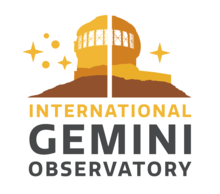  Gemini North in Hawaii and Gemini South in Chile | |||||
 | |||||
| Alternative names | International Gemini Observatory | ||||
|---|---|---|---|---|---|
| Named after | Gemini | ||||
| Organization | Gemini Consortium (NSF-US, NRC-Canada, CONICYT-Chile, MCTI-Brazil, MCTIP-Argentina, KASI-Korea) and AURA | ||||
| Location | Mauna Kea Access Rd, Hawaii, U.S. Cerro Pachón, Chile | ||||
| Coordinates | 19°49′26″N 155°28′11″W / 19.82396°N 155.46984°W 30°14′27″S 70°44′12″W / 30.24073°S 70.73659°W | ||||
| Altitude | 4,213 m (13,822 ft) 2,722 m (8,930 ft) | ||||
| Established | 2000 | ||||
| Website | www | ||||
| Telescopes | |||||
| |||||
| | |||||
The Gemini Observatory comprises two 8.1-metre (26.6 ft) telescopes, Gemini North and Gemini South, situated in Hawaii and Chile, respectively. These twin telescopes offer extensive coverage of the northern and southern skies and rank among the most advanced optical/infrared telescopes available to astronomers. (See List of largest optical reflecting telescopes).
The observatory is owned and operated by the National Science Foundation (NSF) of the United States, the National Research Council of Canada, CONICYT of Chile, MCTI of Brazil, MCTIP of Argentina, and Korea Astronomy and Space Science Institute (KASI) of Republic of Korea. The NSF is the primary funding contributor, providing about 70% of the required resources. The Association of Universities for Research in Astronomy (AURA) manages the operations and maintenance of the observatory through a cooperative agreement with the NSF, acting as the Executive Agency on behalf of the international partners. NSF's NOIRLab is the US national center for ground-based, nighttime optical astronomy and operates Gemini as one of its programs.[1]
The Gemini telescopes are equipped with modern instruments and excel in optical and near-infrared performance. They utilize adaptive optics technology to counteract atmospheric blurring. Notably, Gemini leads in wide-field adaptive optics assisted infrared imaging and has recently commissioned the Gemini Planet Imager, enabling researchers to directly observe and study exoplanets with extreme faintness compared to their host stars. Gemini supports research across various domains of modern astronomy, including the Solar System, exoplanets, star formation and evolution, galaxy structure and dynamics, supermassive black holes, distant quasars, and the structure of the Universe on large scales.
Previously, Australia and the United Kingdom were also involved in the Gemini Observatory partnership. However, the UK withdrew its funding at the end of 2012. In response, the observatory has significantly reduced operating costs, streamlined operations, and implemented energy-saving measures at both sites. Additionally, both telescopes are now operated remotely from Base Facility Operations centers located in Hilo, Hawaii, and La Serena, Chile. In 2018, KASI has signed an agreement to become a full participant of the Gemini Observatory.[2]
- ^ [email protected]. "About". noirlab.edu. Retrieved 2024-07-19.
- ^ "Republic of Korea Becomes a Full Participant in Gemini".